Recognition of DC01 Mild Steel Laser Welding Penetration Status Based on Photoelectric Signal and Neural Network
Abstract
1. Introduction
2. Materials and Methods
2.1. Architecture of the Proposed Approach
2.2. Experimental Equipment
2.3. Experimental Materials and Method
3. Results and Discussion
3.1. Characteristics of Laser Welding Photoelectric Signal
3.2. Wavelet Packet Transform Analysis of Photoelectric Signals
3.3. Probability Density Analysis of Photoelectric Signals
3.4. Feature Extraction of Photoelectric Signal
- (a)
- Mean value: the mean value of the data sample S31 band signal, which reflects the average optical radiation intensity of the laser welding process, is expressed as:
- (b)
- Root mean square (RMS): the RMS value of the data sample S31 band signal is used to measure the deviation between the observed and true values, which can be expressed as:
- (c)
- Standard deviation: this reflects the dispersion degree of the S31 band signal of the data sample, which can be expressed as:
- (d)
- Energy: the energy value of the data sample S31 band signal expressed as:
- (e)
- Maximum probability signal amplitude intensity Vm: after probability density analysis and processing, the data sample signals are extracted and expressed as:where the value of the horizontal coordinate X corresponds to the position of the apex of the center of gravity line in the probability density curve;
- (f)
- PK: the maximum value in the data sample signal, which can be expressed as:
3.5. CNN Network Model
4. Analysis of CNN Model Recognition Results
5. Conclusions
- In the laser welding process, a photoelectric sensor was used to obtain the light intensity signal characteristics of the welding process. There were obvious differences in the amplitude intensity and fluctuation degree of the photoelectric signal under different welding penetration statuses, and the welding penetration status was highly correlated with the characteristics of the photoelectric signal;
- Wavelet packet transform and probability density analysis were used to process the signal and extract the time–frequency characteristics of the signal. The analysis showed that the extracted signal characteristic values could effectively reflect the weld penetration status;
- The welding penetration status recognition model based on a multi-eigenvalue CNN was constructed. The accuracy of the training set was 99.2%, and the classification recognition accuracy could reach 98.5%, which provided the basic method and technology for the online detection of laser welding quality.
Author Contributions
Funding
Institutional Review Board Statement
Informed Consent Statement
Data Availability Statement
Conflicts of Interest
References
- Zhou, Z.; Gao, X.; Zhang, Y. Research Progress on Characterization and Regulation of Forming Quality in Laser Joining of Metal and Polymer, and Development Trends of Lightweight Automotive Applications. Metals 2022, 12, 1666. [Google Scholar] [CrossRef]
- Huang, Y.; Gao, X.; Zhang, Y.; Ma, B. Laser joining technology of polymer-metal hybrid structures-A review. J. Manuf. Process. 2022, 79, 934–961. [Google Scholar] [CrossRef]
- Qiao, J.; Yu, P.; Wu, Y.; Chen, T.; Du, Y.; Yang, J. A Compact Review of Laser Welding Technologies for Amorphous Alloys. Metals 2020, 10, 1690. [Google Scholar] [CrossRef]
- Wang, J.; Fu, X.; Zhang, L.; Zhang, Z.; Liu, J.; Chen, S. A short review on laser welding/brazing of aluminum alloy to steel. Int. J. Adv. Manuf. Technol. 2021, 112, 2399–2411. [Google Scholar] [CrossRef]
- Quazi, M.M.; Ishak, M.; Fazal, M.A.; Arslan, A.; Rubaiee, S.; Qaban, A.; Aiman, M.H.; Sultan, T.; Ali, M.M.; Manladan, S.M. Current research and development status of dissimilar materials laser welding of titanium and its alloys. Opt. Laser Technol. 2020, 126, 106090. [Google Scholar] [CrossRef]
- Zhang, H.; Jiang, M.; Chen, X.; Wei, L.; Wang, S.; Jiang, Y.; Jiang, N.; Wang, Z.; Lei, Z.; Chen, Y. Investigation of Weld Root Defects in High-Power Full-Penetration Laser Welding of High-Strength Steel. Materials 2022, 15, 1095. [Google Scholar] [CrossRef] [PubMed]
- Jiang, Z.; Jiang, Z.; Ding, H. Optical coherence tomography for laser welding applications. Optik 2022, 257, 168784. [Google Scholar] [CrossRef]
- Yu, J.; Lee, H.; Kim, D.-Y.; Kang, M.; Hwang, I. Quality Assessment Method Based on a Spectrometer in Laser Beam Welding Process. Metals 2020, 10, 839. [Google Scholar] [CrossRef]
- Stepanova, K.A.; Kinzhagulov, I.Y.; Yakovlev, Y.O.; Kovalevich, A.S.; Ashikhin, D.S.; Alifanova, I.E. Applying Laser-Ultrasonic and Acoustic-Emission Methods to Nondestructive Testing at Different Stages of Deformation Formation in Friction Stir Welding. Russ. J. Nondestruct. Test. 2020, 56, 191–200. [Google Scholar] [CrossRef]
- Fan, X.a.; Gao, X.; Liu, G.; Ma, N.; Zhang, Y. Research and prospect of welding monitoring technology based on machine vision. Int. J. Adv. Manuf. Technol. 2021, 115, 3365–3391. [Google Scholar] [CrossRef]
- Xiao, R.; Xu, Y.; Hou, Z.; Chen, C.; Chen, S. An adaptive feature extraction algorithm for multiple typical seam tracking based on vision sensor in robotic arc welding. Sens. Actuators A-Phys. 2019, 297, 111533. [Google Scholar] [CrossRef]
- Zhang, X.; Tang, Z.; Wu, Y.; Devoino, O.; Wang, H.; Wang, H. Progress in in situ x-ray imaging of welding process. Rev. Sci. Instrum. 2022, 93, 071501. [Google Scholar] [CrossRef] [PubMed]
- Zeng, W.; Cai, M.; Wang, P.; Lu, T.; Yao, F. Application of laser ultrasonic technique for detecting weld defect based on FDST method. Optik 2020, 221, 165366. [Google Scholar] [CrossRef]
- Gao, X.; Mo, L.; You, D.; Li, Z. Tight butt joint weld detection based on optical flow and particle filtering of magneto-optical imaging. Mech. Syst. Signal Process. 2017, 96, 16–30. [Google Scholar] [CrossRef]
- Gao, X.; Sun, Y.; Katayama, S. Neural Network of Plume and Spatter for Monitoring High-Power Disk Laser Welding. Int. J. Precis. Eng. Manuf. Green Technol. 2014, 1, 293–298. [Google Scholar] [CrossRef]
- Stavropoulos, P.; Bikas, H.; Sabatakakis, K.; Theoharatos, C.; Grossi, S. Quality assurance of battery laser welding: A data-driven approach. Procedia CIRP 2022, 111, 784–789. [Google Scholar] [CrossRef]
- Cai, W.; Wang, J.Z.; Jiang, P.; Cao, L.C.; Mi, G.Y.; Zhou, Q. Application of sensing techniques and artificial intelligence-based methods to laser welding real-time monitoring: A critical review of recent literature. J. Manuf. Syst. 2020, 57, 1–18. [Google Scholar] [CrossRef]
- Elefante, A.; Nilsen, M.; Sikstrom, F.; Christiansson, A.-K.; Maggipinto, T.; Ancona, A. Detecting beam offsets in laser welding of closed-square-butt joints by wavelet analysis of an optical process signal. Opt. Laser Technol. 2019, 109, 178–185. [Google Scholar] [CrossRef]
- Feng, Y.; Gao, X.; Zhang, Y.; Peng, C.; Gui, X.; Sun, Y.; Xiao, X. Simulation and experiment for dynamics of laser welding keyhole and molten pool at different penetration status. Int. J. Adv. Manuf. Technol. 2021, 112, 2301–2312. [Google Scholar] [CrossRef]
- Wang, T.; Gao, X.; Seiji, K.; Jin, X. Study of Dynamic Features of Surface Plasma in High-Power Disk Laser Welding. Plasma Sci. Technol. 2012, 14, 245–251. [Google Scholar] [CrossRef]
- Stavropoulos, P.; Sabatakakis, K.; Papacharalampopoulos, A.; Mourtzis, D. Infrared (IR) quality assessment of robotized resistance spot welding based on machine learning. Int. J. Adv. Manuf. Technol. 2022, 119, 1785–1806. [Google Scholar] [CrossRef]
- Stavropoulos, P.; Papacharalampopoulos, A.; Sabatakakis, K. Robust and Secure Quality Monitoring for Welding through Platform-as-a-Service: A Resistance and Submerged Arc Welding Study. Machines 2023, 11, 298. [Google Scholar] [CrossRef]
- Stavropoulos, P.; Papacharalampopoulos, A.; Stavridis, J.; Sampatakakis, K. A three-stage quality diagnosis platform for laser-based manufacturing processes. Int. J. Adv. Manuf. Technol. 2020, 110, 2991–3003. [Google Scholar] [CrossRef]
- Gao, X.; Li, Z.; Wang, L.; Zhou, X.; You, D.; Gao, P.P. Detection of weld imperfection in high-power disk laser welding based on association analysis of multi-sensing features. Opt. Laser Technol. 2019, 115, 306–315. [Google Scholar] [CrossRef]
- Gao, X.; You, D.; Katayama, S. The high frequency characteristics of laser reflection and visible light during solid state disk laser welding. Laser Phys. Lett. 2015, 12, 76003. [Google Scholar] [CrossRef]
- You, D.; Gao, X.; Katayama, S. A Novel Stability Quantification for Disk Laser Welding by Using Frequency Correlation Coefficient Between Multiple-Optics Signals. IEEE Asme Trans. Mechatron. 2015, 20, 327–337. [Google Scholar] [CrossRef]
- You, D.; Gao, X.; Katayama, S. WPD-PCA-Based Laser Welding Process Monitoring and Defects Diagnosis by Using FNN and SVM. IEEE Trans. Ind. Electron. 2015, 62, 628–636. [Google Scholar] [CrossRef]
- You, D.Y.; Gao, X.D.; Katayama, S. Visual-based spatter detection during high-power disk laser welding. Opt. Lasers Eng. 2014, 54, 1–7. [Google Scholar] [CrossRef]
- Huang, Y.; Hou, S.; Xu, S.; Zhao, S.; Yang, L.; Zhang, Z. EMD- PNN based welding defects detection using laser-induced plasma electrical signals. J. Manuf. Process. 2019, 45, 642–651. [Google Scholar] [CrossRef]
- Li, J.; Zhang, Y.; Liu, W.; Li, B.; Yin, X.; Chen, C. Prediction of penetration based on plasma plume and spectrum characteristics in laser welding. J. Manuf. Process. 2022, 75, 593–604. [Google Scholar] [CrossRef]
- Zhang, Y.; Gao, X.; You, D.; Jiang, X. Online judgment of laser welding process based on time-frequency analyses of in-situ high-speed optical signals. Optik 2022, 265, 169552. [Google Scholar] [CrossRef]
- Zhang, Y.; Gao, X.; You, D.; Zhang, N. Data-Driven Detection of Laser Welding Defects Based on Real-Time Spectrometer Signals. IEEE Sens. J. 2019, 19, 9364–9373. [Google Scholar] [CrossRef]
- Zhang, Y.; You, D.; Gao, X.; Wang, C.; Li, Y.; Gao, P.P. Real-time monitoring of high-power disk laser welding statuses based on deep learning framework. J. Intell. Manuf. 2020, 31, 799–814. [Google Scholar] [CrossRef]
- Miao, R.; Gao, Y.; Ge, L.; Jiang, Z.; Zhang, J. Online defect recognition of narrow overlap weld based on two-stage recognition model combining continuous wavelet transform and convolutional neural network. Comput. Ind. 2019, 112, 103115. [Google Scholar] [CrossRef]
- Miao, R.; Shan, Z.; Zhou, Q.; Wu, Y.; Ge, L.; Zhang, J.; Hu, H. Real-time defect identification of narrow overlap welds and application based on convolutional neural networks. J. Manuf. Syst. 2022, 62, 800–810. [Google Scholar] [CrossRef]
- Zhang, Y.; You, D.; Gao, X.; Katayama, S. Online Monitoring of Welding Status Based on a DBN Model During Laser Welding. Engineering 2019, 5, 671–678. [Google Scholar] [CrossRef]
- He, K.; Xia, Z.; Si, Y.; Lu, Q.; Peng, Y. Noise Reduction of Welding Crack AE Signal Based on EMD and Wavelet Packet. Sensors 2020, 20, 761. [Google Scholar] [CrossRef]
- Ma, D.; Jiang, P.; Shu, L.; Geng, S. Multi-sensing signals diagnosis and CNN-based detection of porosity defect during Al alloys laser welding. J. Manuf. Syst. 2022, 62, 334–346. [Google Scholar] [CrossRef]
- Huang, W.; Gao, X.; Huang, Y.; Zhang, Y. Improved Convolutional Neural Network for Laser Welding Defect Prediction. Int. J. Precis. Eng. Manuf. 2023, 24, 33–41. [Google Scholar] [CrossRef]
- Yang, Y.; Pan, L.; Ma, J.; Yang, R.; Zhu, Y.; Yang, Y.; Zhang, L. A High-Performance Deep Learning Algorithm for the Automated Optical Inspection of Laser Welding. Appl. Sci. Basel 2020, 10, 933. [Google Scholar] [CrossRef]
- Hartl, R.; Bachmann, A.; Habedank, J.B.; Semm, T.; Zaeh, M.E. Process Monitoring in Friction Stir Welding Using Convolutional Neural Networks. Metals 2021, 11, 535. [Google Scholar] [CrossRef]
- Shin, S.; Jin, C.; Yu, J.; Rhee, S. Real-Time Detection of Weld Defects for Automated Welding Process Base on Deep Neural Network. Metals 2020, 10, 389. [Google Scholar] [CrossRef]
- Pastras, G.; Fysikopoulos, A.; Chryssolouris, G. A numerical approach to the energy efficiency of laser welding. Int. J. Adv. Manuf. Technol. 2017, 92, 1243–1253. [Google Scholar] [CrossRef]

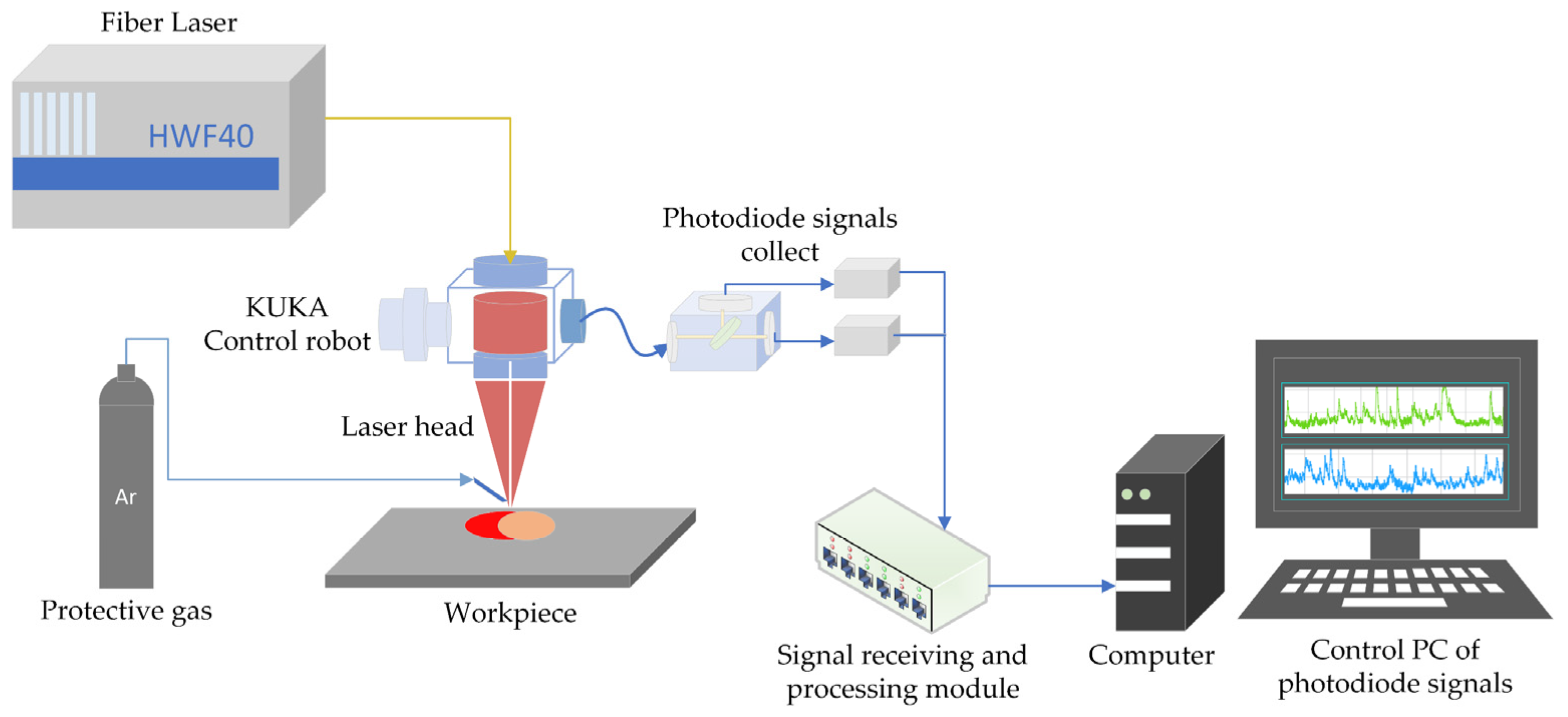
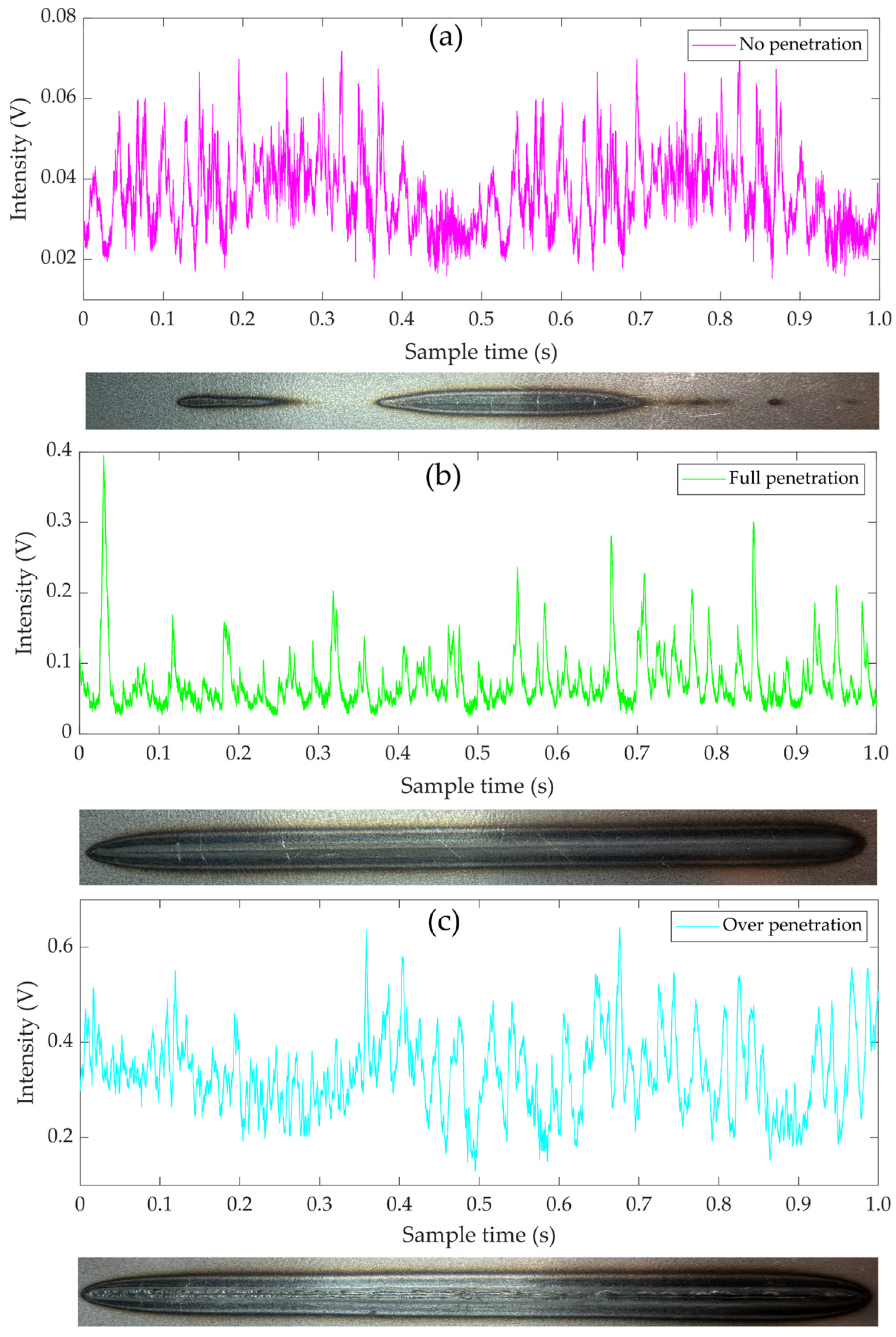
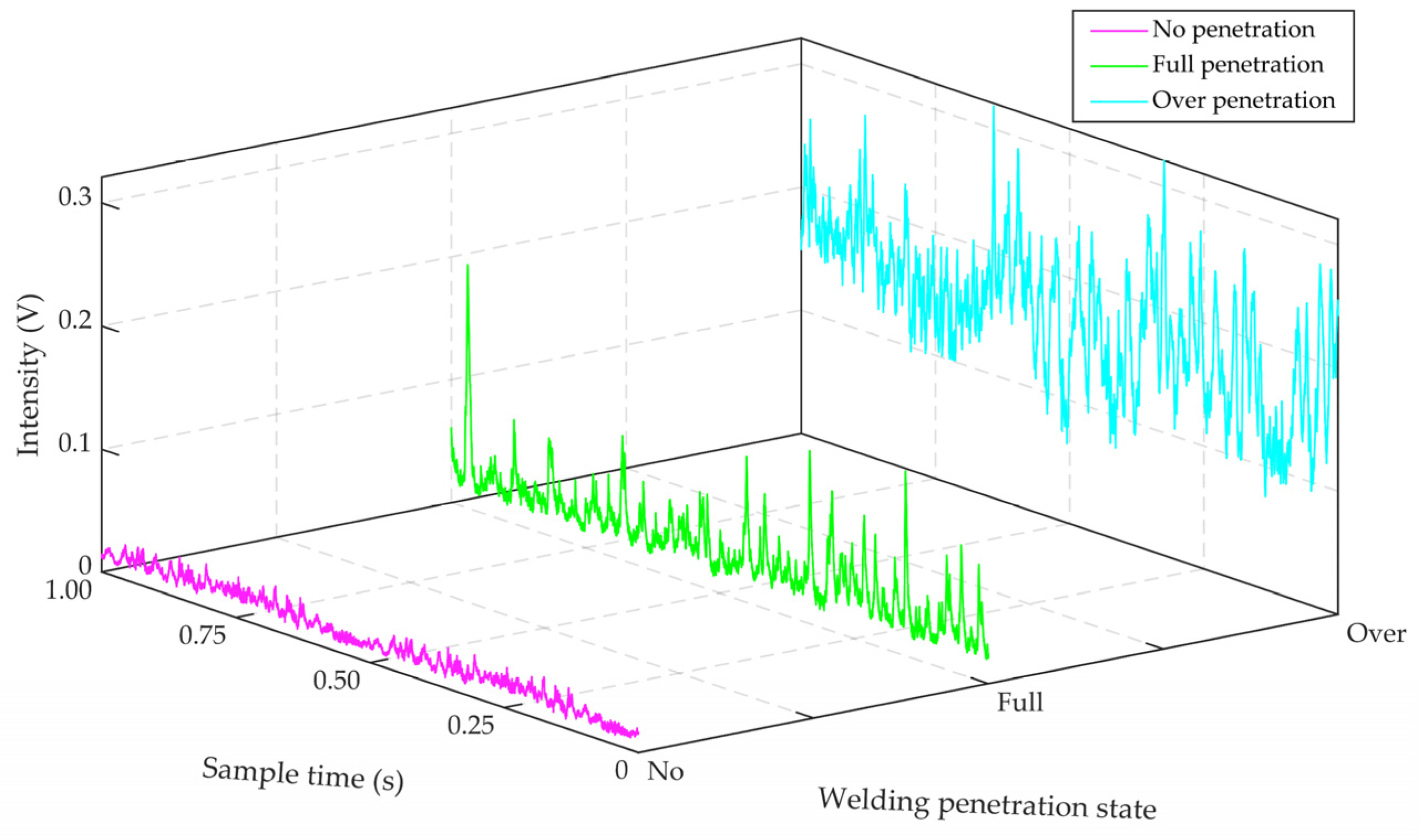
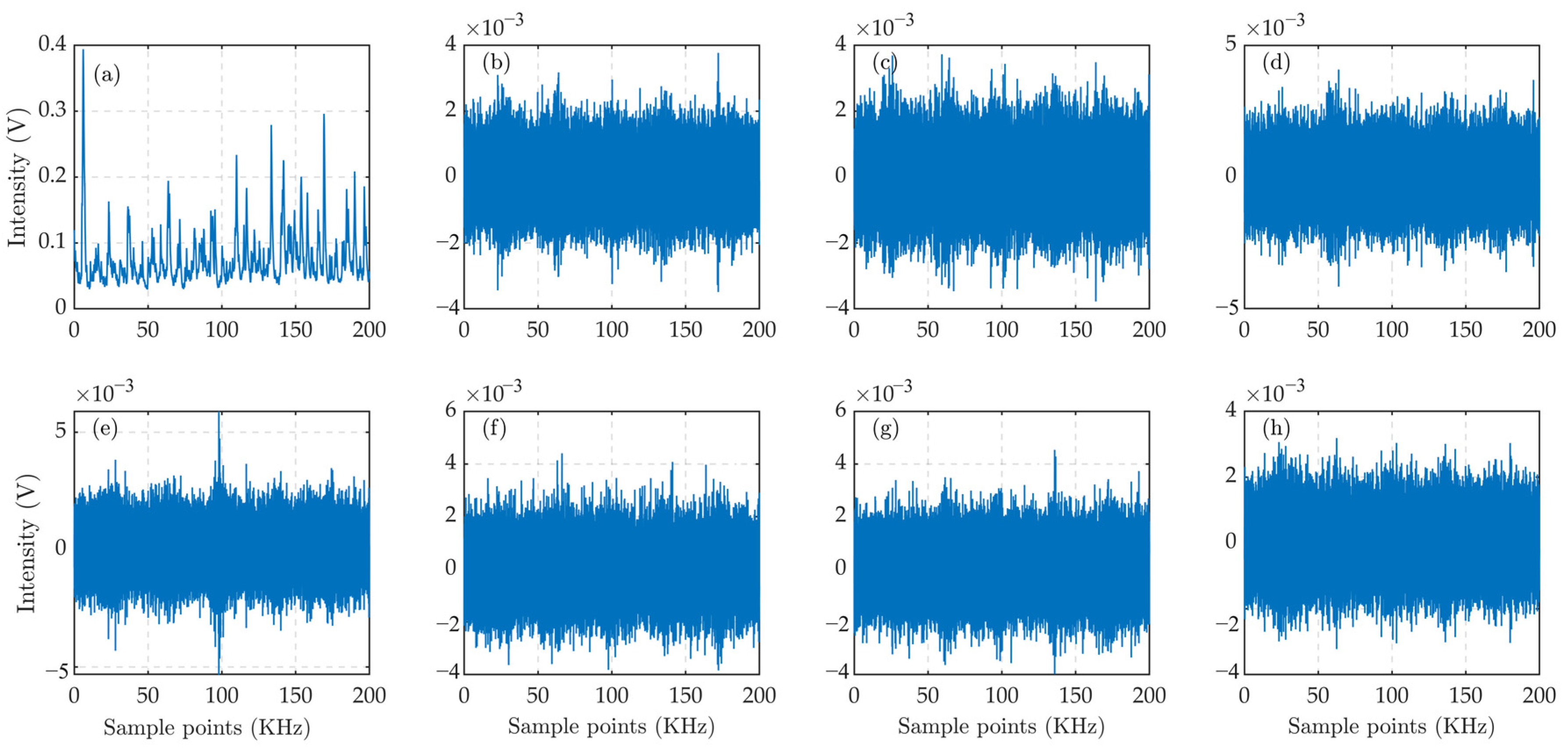
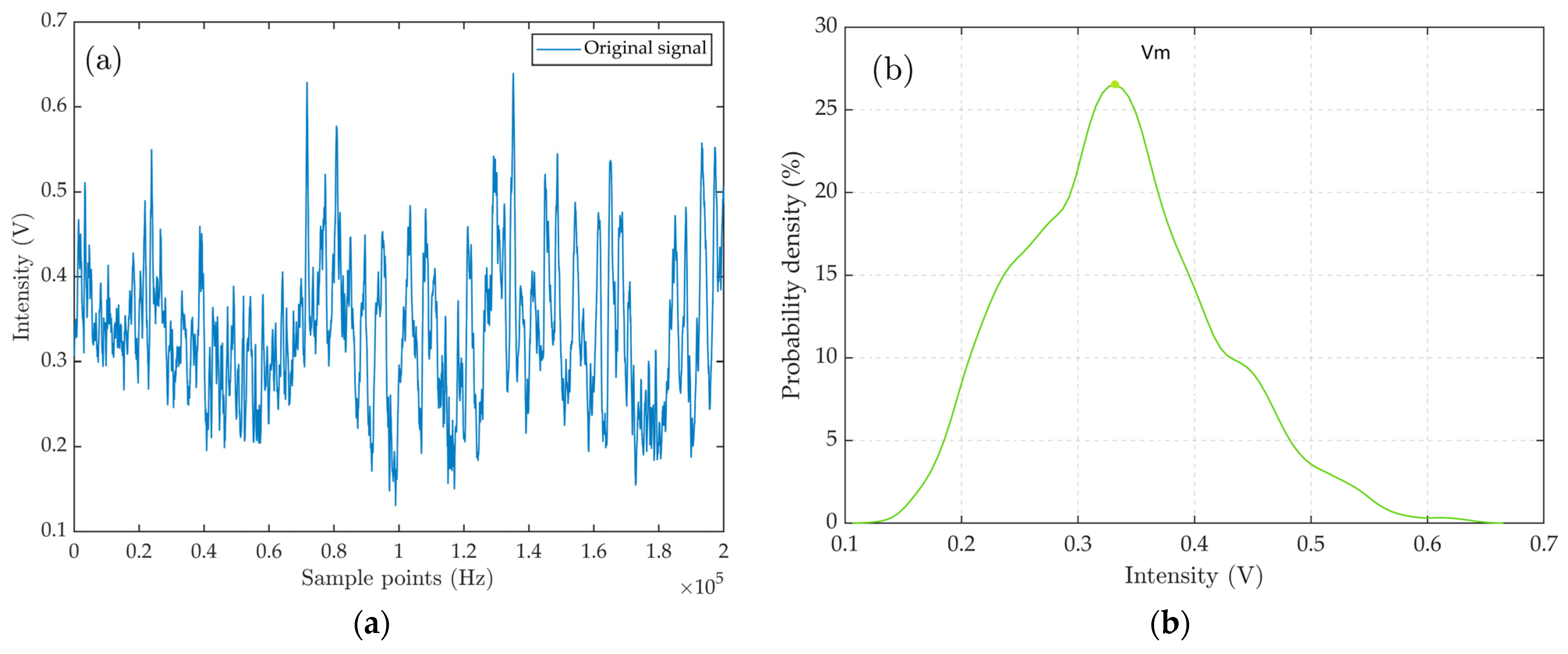
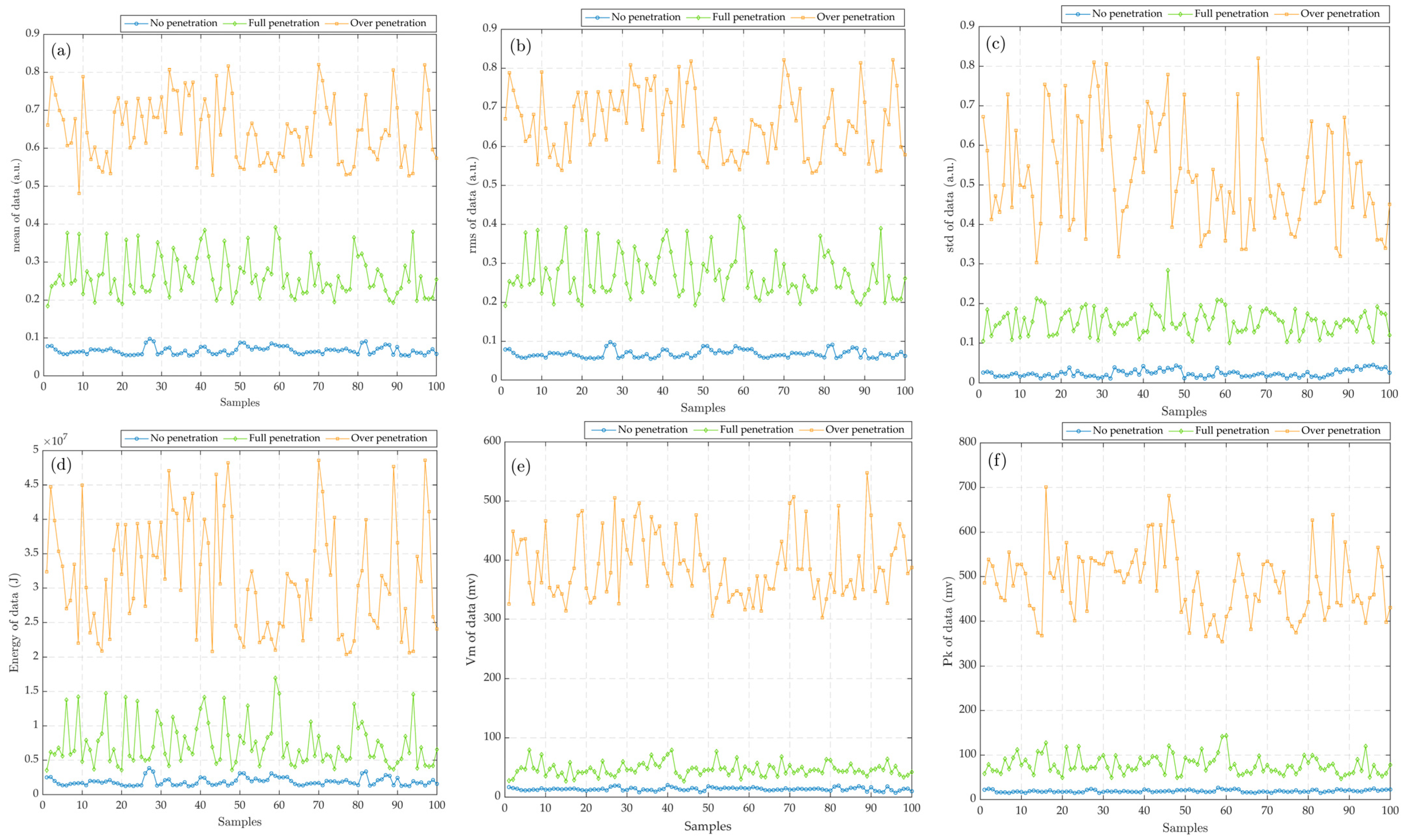
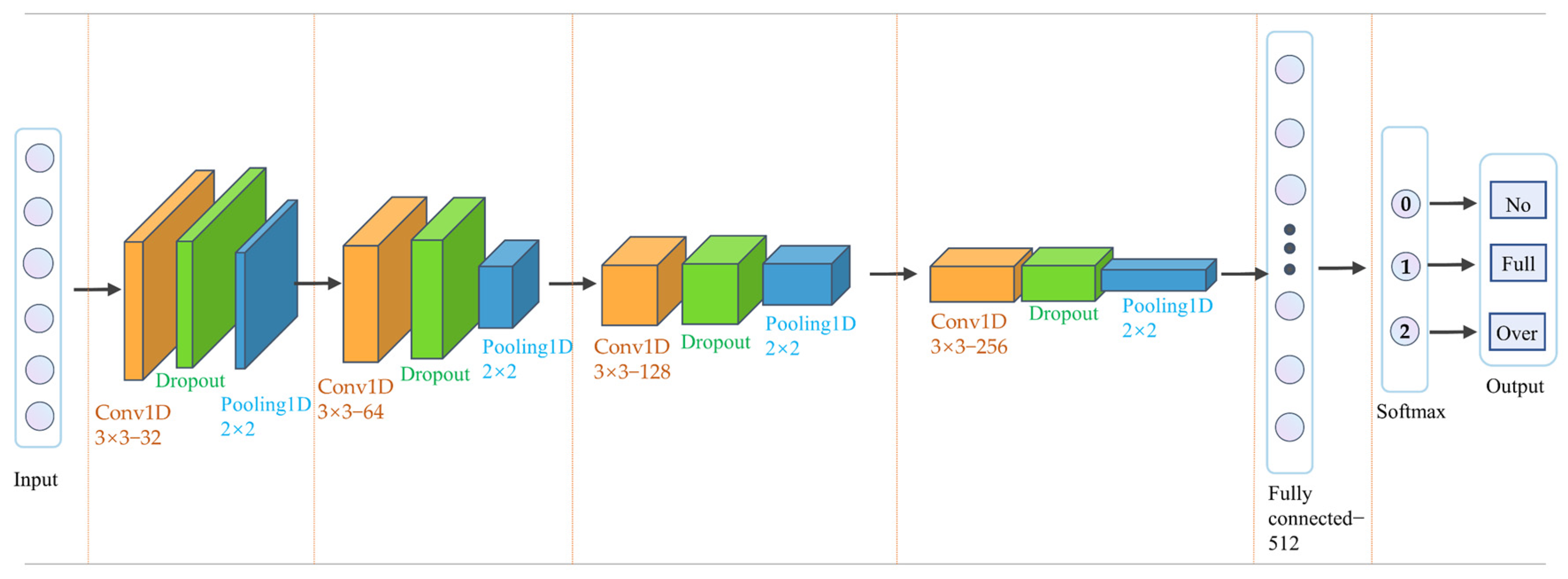
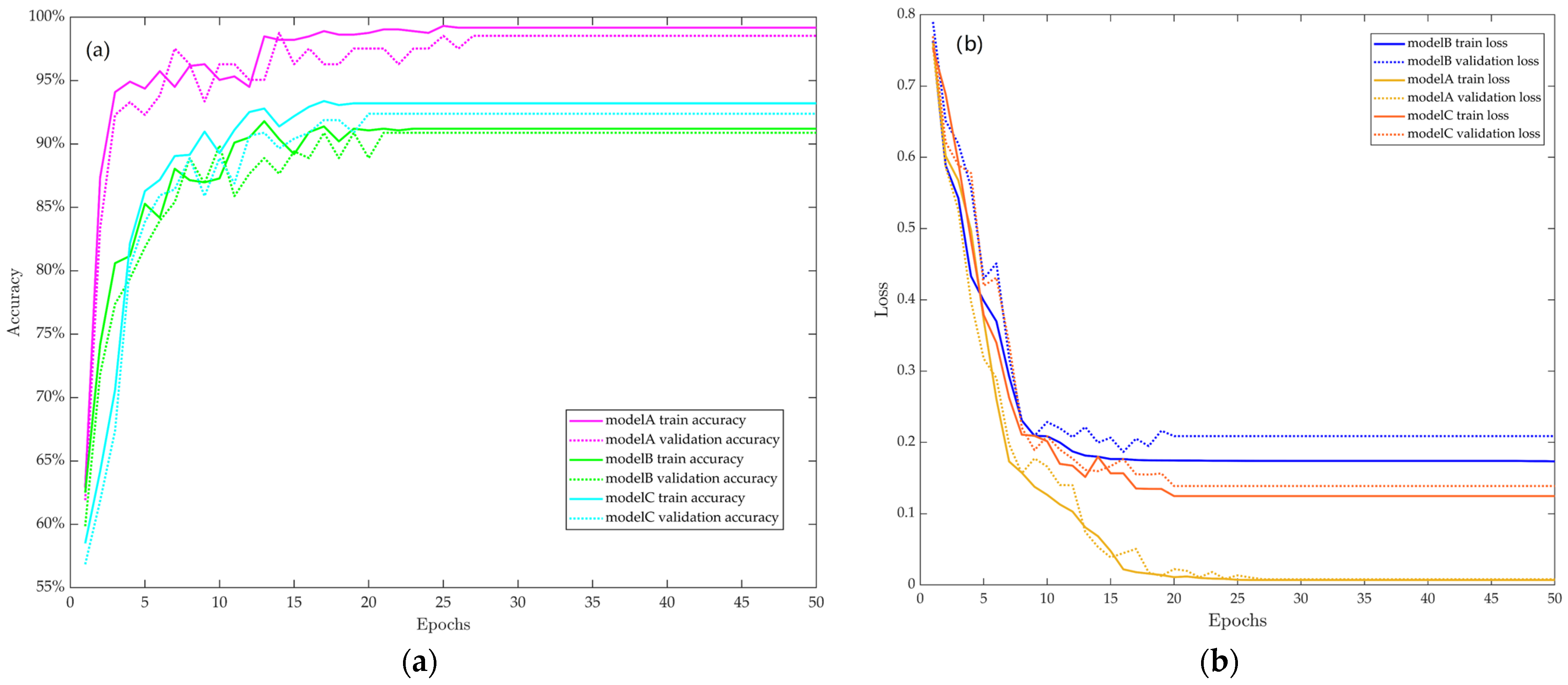
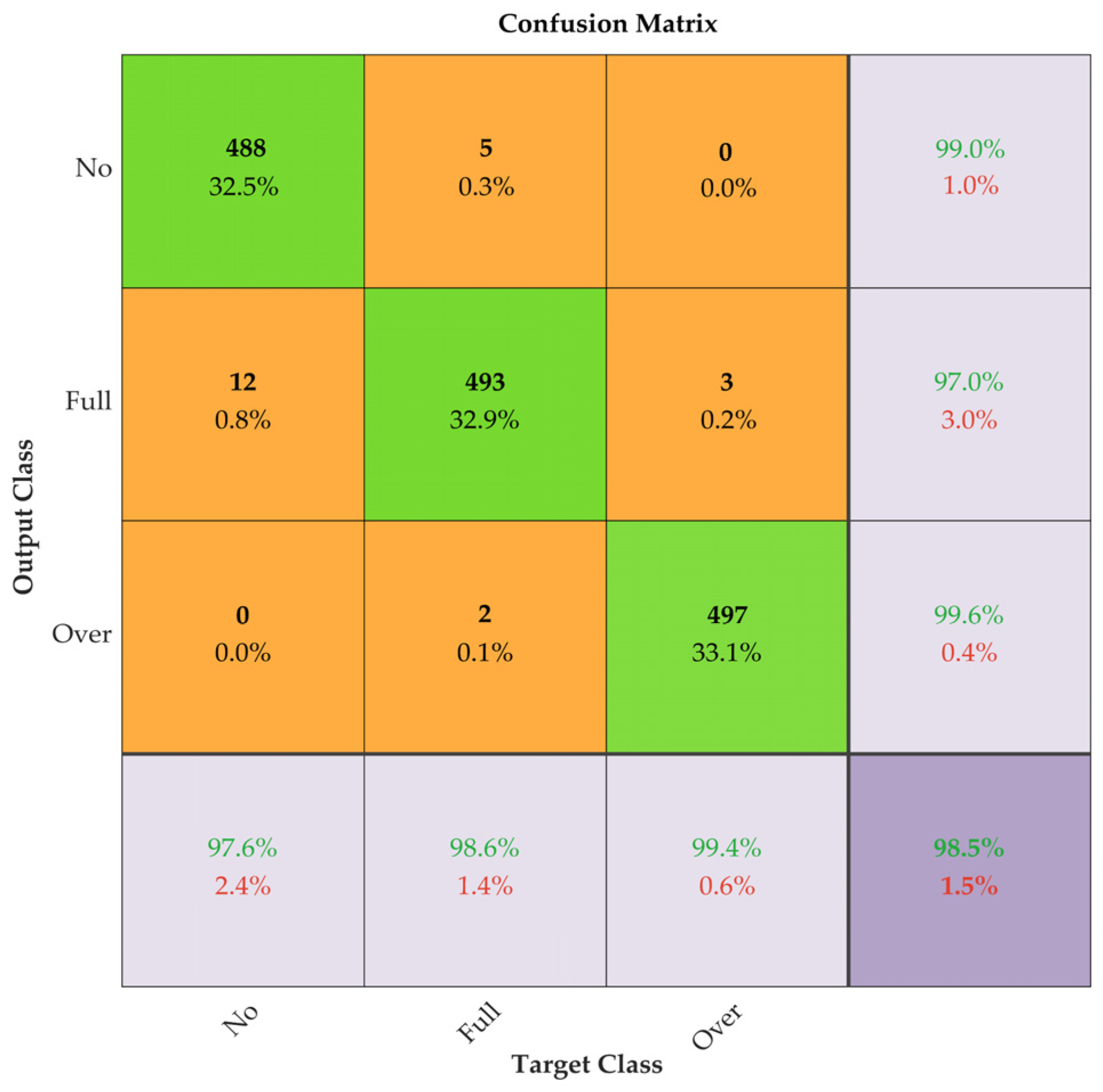

| C | Mn | P | S |
|---|---|---|---|
| ≤0.12 | ≤0.60 | ≤0.045 | ≤0.045 |
| Experimental Number | Power (kW) | Speed (m/min) | Defocus (mm) | Gas (L/min) | Penetration Status | Sample Result |
|---|---|---|---|---|---|---|
| 1 | 1.5 | 2 | 0 | 25 | No penetration |  |
| 2 | 1.8 | 2 | 0 | 25 | No penetration |  |
| 3 | 2.0 | 2 | 0 | 25 | No penetration |  |
| 4 | 2.2 | 2 | 0 | 25 | Full penetration |  |
| 5 | 2.5 | 2 | 0 | 25 | Full penetration |  |
| 6 | 2.8 | 2 | 0 | 25 | Full penetration |  |
| 7 | 3.0 | 2 | 0 | 25 | Over-penetration |  |
| 8 | 3.2 | 2 | 0 | 25 | Over-penetration |  |
| 9 | 3.5 | 2 | 0 | 25 | Over-penetration |  |
| Extracted Features | Xmean | Xrms | Xstd | E3j | Vm | Pk |
|---|---|---|---|---|---|---|
| Correlation coefficient | 0.92 | 0.95 | 0.93 | 0.95 | 0.96 | 0.91 |
Disclaimer/Publisher’s Note: The statements, opinions and data contained in all publications are solely those of the individual author(s) and contributor(s) and not of MDPI and/or the editor(s). MDPI and/or the editor(s) disclaim responsibility for any injury to people or property resulting from any ideas, methods, instructions or products referred to in the content. |
© 2023 by the authors. Licensee MDPI, Basel, Switzerland. This article is an open access article distributed under the terms and conditions of the Creative Commons Attribution (CC BY) license (https://creativecommons.org/licenses/by/4.0/).
Share and Cite
Niu, Y.; Gao, P.P.; Gao, X. Recognition of DC01 Mild Steel Laser Welding Penetration Status Based on Photoelectric Signal and Neural Network. Metals 2023, 13, 871. https://doi.org/10.3390/met13050871
Niu Y, Gao PP, Gao X. Recognition of DC01 Mild Steel Laser Welding Penetration Status Based on Photoelectric Signal and Neural Network. Metals. 2023; 13(5):871. https://doi.org/10.3390/met13050871
Chicago/Turabian StyleNiu, Yue, Perry P. Gao, and Xiangdong Gao. 2023. "Recognition of DC01 Mild Steel Laser Welding Penetration Status Based on Photoelectric Signal and Neural Network" Metals 13, no. 5: 871. https://doi.org/10.3390/met13050871
APA StyleNiu, Y., Gao, P. P., & Gao, X. (2023). Recognition of DC01 Mild Steel Laser Welding Penetration Status Based on Photoelectric Signal and Neural Network. Metals, 13(5), 871. https://doi.org/10.3390/met13050871






